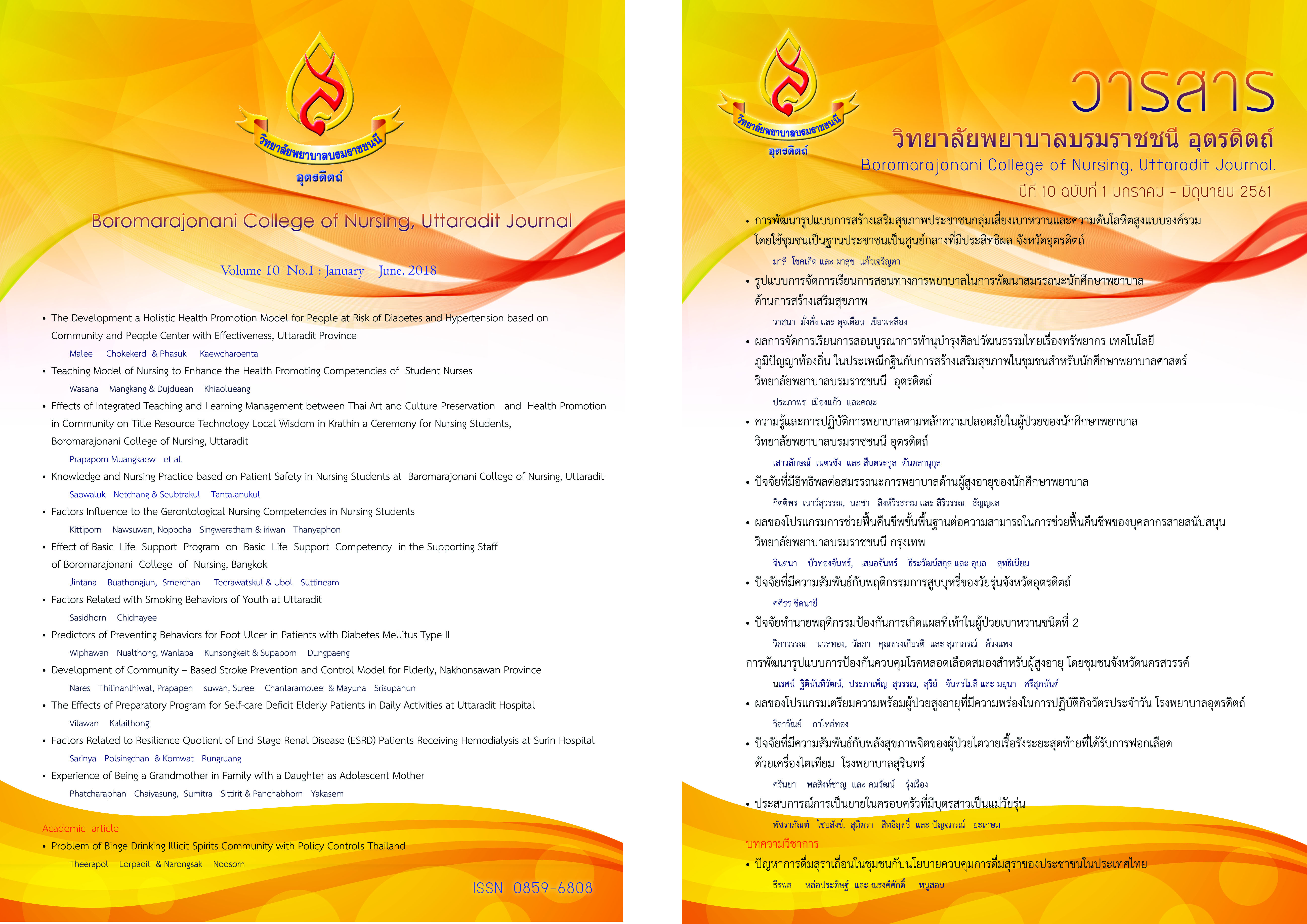ประสบการณ์การเป็นยายในครอบครัวที่มีบุตรสาวเป็นแม่วัยรุ่น
Main Article Content
บทคัดย่อ
การเป็นยายในครอบครัวที่มีบุตรสาวเป็นแม่วัยรุ่นพบปัญหาหลายประการ ได้แก่ การปรับตัวต่อการเปลี่ยนผ่านบทบาท การเผชิญหน้ากับค่านิยมทางวัฒนธรรม และบรรทัดฐานทางสังคมในด้านลบ การศึกษาครั้งนี้เป็นวิจัยเชิงคุณภาพแบบพรรณนา มีวัตถุประสงค์เพื่อทำความเข้าใจประสบการณ์การเป็นยายในครอบครัวที่มีบุตรสาวเป็นแม่วัยรุ่น คัดเลือกผู้ให้ข้อมูลแบบเฉพาะเจาะจง เป็นมารดาที่มีลูกสาวเป็นแม่วัยรุ่นจำนวน 15 ราย ในเขตภาคกลางของประเทศไทย เก็บรวบรวมข้อมูลโดยใช้การสัมภาษณ์เชิงลึก และการสังเกตแบบไม่มีส่วนร่วม วิเคราะห์ข้อมูลด้วยการวิเคราะห์เนื้อหา
ผลการศึกษาพบว่า มารดาที่มีบุตรเป็นแม่วัยรุ่นมีการรับรู้เกี่ยวกับประสบการณ์การเป็นยายในด้านบวก โดยมีแก่นสาระสำคัญ คือ ก้าวข้ามผ่านปัญหา ประกอบด้วย 4 ประเด็นย่อย ได้แก่เป็นประสบการณ์ที่มีคุณค่า ครอบครัวได้เรียนรู้ เยียวยาบาดแผลที่เกิดขึ้น และแม่วัยรุ่นมีความเป็นผู้ใหญ่มากขึ้นและการรับรู้ประสบการณ์การเป็นยายในด้านลบ สรุปแก่นสาระสำคัญได้ 2 ประเด็นหลัก คือ 1) เป็นตราบาปของครอบครัวประกอบด้วย 3 ประเด็นย่อย ได้แก่ เป็นเวรกรรมที่ทำไว้ ต้องอดทนต่อสายตาคนมอง และเจ็บปวดทุกครั้งที่คนถาม 2) ทุกอย่างต้องปรับตัวประกอบด้วย 2 ประเด็นย่อย ได้แก่ เมื่อครอบครัวเดี่ยวกลายเป็นครอบครัวขยาย และเมื่อรายจ่ายมากกว่ารายรับ
การรับรู้เกี่ยวกับประสบการณ์การเป็นยาย เกี่ยวกับบทบาทในการเป็นผู้เลี้ยงดูสมาชิกในครอบครัวตามบริบทและค่านิยมของสังคมไทยมีทั้งในด้านบวกและด้านลบ ดังนั้นการให้ความช่วยเหลือแก่มารดาในกลุ่มดังกล่าวจึงถือได้ว่ามีความจำเป็นเพื่อส่งเสริมให้ครอบครัวไทยสามารถเลี้ยงดูสมาชิกให้เติบโตได้อย่างมีประสิทธิภาพ
Article Details
บทความหรือข้อคิดเห็นใดใดที่ปรากฏในวารสารวิจัยการพยาบาลและวิทยาศาสตร์สุขภาพ เป็นวรรณกรรมของผู้เขียน ซึ่งบรรณาธิการหรือสมาคมศิษย์เก่า ไม่จำเป็นต้องเห็นด้วย และบทความที่ได้รับการตีพิมพ์เผยแพร่ถือเป็นลิขสิทธิ์ของวารสารวิจัยการพยาบาลและวิทยาศาสตร์สุขภาพ
References
2. Bureau of reproductive health, department of health. (2016, July 15). Reproductive health situation in adolescence and youth in 2016. Retrieved from https://rh.anamai.moph.go.th/more_nnew.php?cid=1&filename=index (in Thai)
3. Cook, G.A.& Roggman, L.A.(2010). Three-generation attachment: How grandmothers and mothers contribute to children’s attachment security. Family Science, 1 (2), 112 - 122.
4. Elo, S., & Kyngas, H. (2007).The qualitative content analysis process.JAN: Research Methodology, 107-115.
5. Giugliani, E.R.A., Nunes, L.M., Issler, R.M.R., Santo, L.C., and Oliveira, L.D.(2017, August 1). Involvement of maternal grandmother and teenage mother in intervention to reduce pacifier use: a randomized clinical trial. Journal de Pediatria, Retrieved from https://doi.org/10.1016/j.jped.2017.12.011
6. Lincon, Y.S., and Guba, E.G. (1985). Naturalistic inquiry.Beverly Hills, CA: Sage.
7. Mercer, R.T. (1995). Becoming a mother: Research on maternal role identity from Rubin to the present. USA: Springer publishing company.
8. Pansuwan, K. (2015). Quality of life among Postpartum Adolescents mothers in TambonMuang, Kamphaeng Phet Provience. Journal of Nursing and Health Science, 9(2), 1-9. (in Thai)
9. Pansuwan, K. & Sinarakud, T. (2016). Effect of the gagne based - contraceptive-instructional model on learning achivement for postpartum adolescents in Phichit hospital. Boromarajonani College of Nursing, Uttaradit Journal, 8(2), 37-46. (in Thai)
10. Pungbangkadee, R. and Ratinthorn, A. (2014). Factors and consequences of repeat pregnancy among teenagers: A case study in Bangkok metropolis. Journal of Nursing Science, 32 (2), 23-31. (in Thai)
11. Punsuwun, S., Sungwan, P., Monsang, I. and Chaiban P. (2012).Experiences after pregnancy among unmarried adolescents in upper north. Songklanagarind Journal of Nursing. , 33(3), 17-36. (in Thai)
12. Rosengard, Cynthia, Pollock, Lealah, Weitzen, Sherry, Meers, Ann, and Phipps, Maureen G. (2006).Concepts of the advantages and disadvantages of teenage childbearing among pregnant adolescents: A qualitative analysis. Pediatrics, 118(2), 503-510.
13. Sangpraseart, A., Klayjun, P., and Masukkampheangjinda. (2014). The relationship between perceived self-efficacy and postpartum self-care behaviors in adolescent mothers. Boromarajonani College of Nursing, Uttaradit Journal, 6(1), 1-11. (in Thai)
14. Seamark, C.J. & Lings, P. (2004).Positive experiences of teenage motherhood: a qualitative study. British Journal of General Practice, 813-818.
15. Suktouryat, W. (2008).Lessons learned from reflection of female school drop-outs with unwanted pregnancy. Independent study master of education, department of educational psychology and Guidance, graduate school Chiang Mai university, Chiang Mai. (in Thai)
16. Yakasem, P. (2015). Becoming a Thai adolescent mother. dissertation doctor of philosophy in nursing science, graduate school, Burapha university. (in Thai)
17. Yakasem, P. and Chaiyasung, P. (2014).Experiences of becoming a teenage mother. Journal of Health Science Research,8(1), 28-34. (in Thai)
18. Zeiders, K.H., Umana-Taylor, A.J., Jahromi, L.B., and Updegraff, K.A.(2015). Grandmothers’ familism values, adolescent mothers’ parenting efficacy, and children’s well-being. Journal of Family Psychology, 29(4), 624-634.

